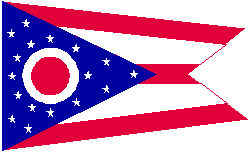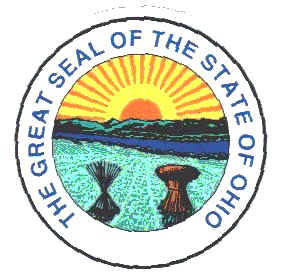
Ohio is unusual in having
the only state flag that is not rectangular. Based on the Cavalry Guidon carried
during the Civil War, the pennant shaped flag displays a modified version of the
stars and stripes. The shape is a tapered burgee.
The
seventeen stars refer to Ohio's position as the seventeenth state to join the
United States. Ohio entered the Union March 1, 1803.
The
red circle represents the Buckeye, the Ohio state tree, surrounding the Buckeye
is a white O, this is for OHIO. The blue triangle represents the hills and the
valleys. The red and white stripes signify the Ohio's rivers and highways. The
top, middle and bottom stripes are red, the other two are white.
The
flag flew for the first time over the Ohio Building at the 1901Pan-American
Exposition in Buffalo, New York.
The
flag was designed by John Eisenmann in 1901. The Ohio legislature adopted the
flag May 9, 1902.
5.01 Official flag of state
The flag of the state shall be pennant shaped. It shall have three red and
two white horizontal stripes. The union of the flag shall be seventeen
five-pointed stars, white in a blue triangular field, the base of which shall be
the staff end or vertical edge of the flag, and the apex of which shall be the
center of the middle red stripe. The stars shall be grouped around a red disc
superimposed upon a white circular "O." The proportional dimensions of
the flag and of its various parts shall be according to the official design on
file in the office of the secretary of state. One state flag of uniform
dimensions shall be furnished to each company of the organized militia.
Historical and Statutory Notes
Pre-1953 H 1 Amendments: 124 v H 379; 106 v 341 95 v 445
Cross References
Desecration of flag prohibited, 2927.11
Display of the national flag, 3313.80
Ohio historical society to have custody of design, letters of patent
and assignment of patent of state flag, 111.08
Powers and duties of Ohio historical society, 149.30
Trademarks not to contain state flag, 1329.55
Library References
States key 23.
WESTLAW Topic No.360.
C.J.S. States § 39.
OJur 3d: 84, State of Ohio § 8
Am Jur 2d:35, Flag § 1,2

old design
The State Seal
The current design of the Great Seal of the State of Ohio was officially
adopted in 1967 and modified in 1996. In the foreground, a sheaf of wheat
represents Ohio's agricultural strength. A bundle of 17 arrows symbolizes Ohio's
status as the 17th state admitted to the union. Thirteen rays around the sun
represent the thirteen original colonies shining over the first state in the
Northwest Territory. The background contains a portrayal of Mount Logan, with a
three-quarter full sun rising behind it--symbolizing that Ohio was the first
state west of the Allegheny Mountains. The Scioto River flows between the
mountain and the cultivated fields in the foreground. Here is the section of the
Ohio Revised Code describing the state seal:
§ 5.04 Coat of arms of state.
The coat of arms of the state shall consist of the following device: a
circular shield; in the right foreground of the shield a full sheaf of wheat
bound and standing erect; in the left foreground, a cluster of seventeen arrows
bound in the center and resembling in form the sheaf of wheat; in the
background, a representation of Mount Logan, Ross county, as viewed from Adena
state memorial; over the mount, a rising sun three-quarters exposed and
radiating thirteen rays to represent the thirteen original colonies shining over
the first state in the northwest territory, the exterior extremities of which
rays form a semicircle; and uniting the background and foreground, a
representation of the Scioto river and cultivated fields.
The coat of arms of the state shall correspond substantially with the
following design:
When the coat of arms of the state is reproduced in color, the colors used
shall be substantially the same as the natural color of the terrain and objects
shown.
HISTORY: RS § 15; S&S 729; 65 v 175; GC § 30; Bureau of Code Revision,
10-1-53; 132 v H 164 (Eff 12-15-67); 146 v S 213. Eff 11-20-96.
